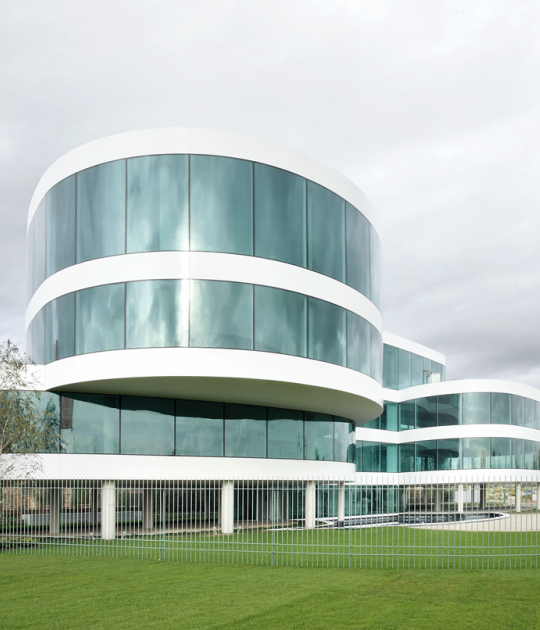Zhuhai is a recently created city located opposite Hong Kong, in the west bank of Pearl River estuary, on the southern coast of China. It was created in 1979 and one year later it was included as one of the original Special Economic Zones that were established in the 1980s. Zhuhai City is also a resort area where Chinese tourists and many people from nearby Hong Kong and Macau go for entertainment attracted by the lower prices.
The new Zhuhai Huafa Museum for Contemporary Art is a step forward towards the transformation of Zhuhai into a leading centre of social change, influenced by Chinese who are returning to the city after having worked in the West.
On its roof, a large square is created with obviously topological actions that form an irregular topography and secondary squares, from where we obtain a complete visual of the city. These squares are formed around of the most notable parts of the building, which are the structures that make analogies to trees, growing from the inside. They create circular courtyards that allow the entry of light into them and, consequently, into the interior rooms of the museum. The trees cover near the totality of the square and give the building a horizontality quality, in order to obtain more homogeneous proportions in height.
Topologically, the references with another project developed previously by this studio, for the competition for the construction of the Performing Arts Centre in Taipei (2009), could be observed. This project relates the origins of humanity and the people’s customs of forming a group, in circles, around others that spoke, sang and talked together; if it was possible around a tree. The geometry of the whole could be understood as a rain forest formed by a stratified structure, while environmental strategies are used, and a functional block diagram is constructed. Among the trees, the roof unfolds to protect from the sun and the rain, proposing on the same one a new landscape roof, with city sights, to be visit.
It is significant in this proposal the disciplinary integration between architecture, landscape and environment, in the search for, what the authors themselves have called, a new "thermodynamic beauty."
Description of project by Ábalos + Sentkiewicz arquitectos.
The museum is the product of an interest in addressing the place and the brief by introducing a tension between the solid, closed vocation of the museum spaces, and the desire to generate a specific festive world in the open air, emerging and showing itself above the building in the form of a great panoramic lookout tower.
The central theme of the project is then, counterposing a space or landscape that opens up to the outside and a protective building that twists around a series of central courtyards, finding in this duality the germ of a new prototype of museum adapted not just to local climate conditions, but also to the need to offer new ways of bringing culture to China’s emerging classes.
This compositive duality or contraposition becomes an opportunity to try out new climate control techniques based on the interaction between the two spatial modalities involved in the composition of the building.
CREDITS.-
Zhuhai Huafa Contemporary art Museum, Zhuhai, Guangdong, China, 2013.
International competition by invitation. FIRST PRIZE
Client.- Zhuhai Huafa Investment Group Co.,Ltd.
Site.- Zhuhai, Guangdong, China.
Program.- Exhibition Space 11.212 m², Art communication 1.854 m², Research center 491 m², Artist studio 924 m², Administration 771 m², Affiliated facilities 3673 m², Storage 2380 m², Circulation+Other services 3687 m².
Built area.- 24.992 m².
Status.- Project under development.
Competition.-
Architecture.- Ábalos + Sentkiewicz arquitectos.
Local Architects.- Atelier L+ (Linxue Li).
Project directors.- Iñaki Ábalos, Renata Sentkiewicz.
Collaborators.- Timothy Brennan, Chenchen Hu, Weilun Tsui (Cambridge), María Auxiliadora Gálvez, Juan Enríquez, Ana Fernández, Elena Vallejo, Alvaro Maján, Marina Bicca (Madrid) (Ábalos+Sentkiewicz arquitectos), Yin Hongde, Li Huanhuan, Ni Runer, Liu Jieling, Wangyiqing (Atelier L+).
Energy y sustainability.- Bing Wang/ Salmaan Craig.
Structure.- Hanif Kara.
Schematic design.-
Architecture.- Ábalos + Sentkiewicz arquitectos.
Project directors.- Iñaki Ábalos, Renata Sentkiewicz.
Collaborators.- Timothy Brennan, Chenchen Hu (Cambridge) Juan Enríquez, Alvaro Maján (Madrid) (Ábalos+Sentkiewicz arquitectos).
Local consultants.- TJAD (Tongji University Architectural Design and Research Institute).









































